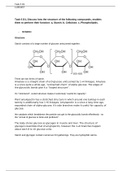Answers
Task 5 D1 Unit 13 - Understand and Interpret Animal Behaviour and Communication
- Course
- Institution
Task 5 D1 Unit 13 - Understand and Interpret Animal Behaviour and Communication (THIS WILL SHOW UP IN THE MARK BOOK AS PLAGIARISM AND YOU WILL GET EXCLUDED OUT THE COURSE) THIS WORK IS MEANT TO BE AS A REFERENCE OR GUIDANCE FOR YOU'RE WORK PLEASE RESPECT MY WORK AND MAKE SURE YOU GIVE ME CREDIT OR ...
[Show more]



